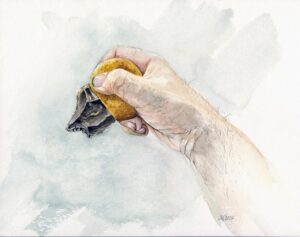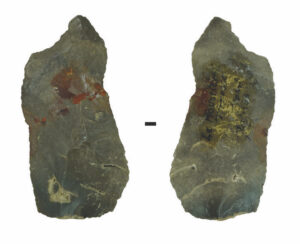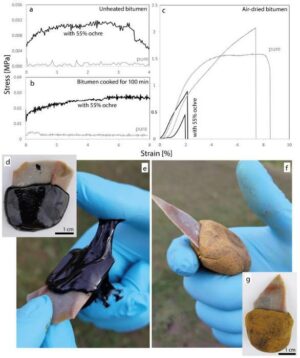
AMERICAN ASSOCIATION FOR THE ADVANCEMENT OF SCIENCE (AAAS)—Artifacts from Le Moustier, a Middle Paleolithic site in France, offer the earliest evidence from Europe for the use of ochre – a clay pigment containing iron oxide – to produce less-sticky, “gripping” adhesives used for a variety of tools, according to a new study. Although Neanderthals are known to have produced adhesives with similar properties to make hand grips, ochre-based compound adhesives had previously only been associated with Homo sapiens in Africa, Patrick Schmidt and colleagues say. “If anatomically modern humans brought this knowledge with them during their Out-of-Africa migration, its presence at Le Moustier would document a remarkably long technological continuity,” the authors speculate, noting that these adhesives could also have been produced by Neanderthals independently. Ancient materials such as adhesives, which were used for attaching tool pieces together, are among the best evidence archaeologists have found to understand the cognitive abilities and cultural transmission of early modern humans and Neanderthals. Evidence from the Middle Paleolithic era, or Middle Stone Age, between 300,000 and 30,000 years ago, suggests that Neanderthals in Europe produced adhesives from bitumen, tree resins, and birch bark. Meanwhile, Homo sapiens in Africa concocted recipes for compound adhesives by combining Podocarpus trees or other naturally sticky substances with materials such as ochre, quartz, or bone fragments. Here, Schmidt et al. report some of the earliest evidence that ochre-based adhesives were also produced in Europe in the Middle Paleolithic. The researchers examined five well-preserved artifacts, including flakes, a blade, and a scraper containing traces of red, yellow, and black residue, all of which were originally found at Le Moustier, a site associated with the Mousterian stone tool industry. Chemical and structural analyses revealed that the residue was made by mixing bitumen – a black, sticky, petroleum-based substance – with goethite ochre, similar to Middle Stone Age adhesives found in Africa. Experiments confirmed that mixing bitumen and goethite ochre could produce an adhesive that was ideal for gripping rather than gluing parts together.
___________________________

Reconstruction of how the stone artifact with the handle could be held by a Neanderthal.
Staatliche Museen zu Berlin, Museum für Vor- und Frühgeschichte, illustration: Daniela Greinert.
______________________________

Stone artifact with remains of the bitumen-ocher mixture that come from the upper rock shelter of Le Moustier. Inventory number Va 7158.7. Staatliche Museen zu Berlin, Museum für Vor- und Frühgeschichte, photo: Gunther Möller
______________________________

Experiments investigating the benefit of goethite ochre in bitumen-based adhesives. Schmidt et al., Sci. Adv. 10, eadl0822 (2024)
______________________________
Article Source: AAAS news release.
*Ochre-based compound adhesives at the Mousterian type-site document complex cognition and high investment, Science Advances, 21-Feb-2024. www.science.org/doi/10.1126/sciadv.adl0822

See the incredible archaeology, architecture, and art of northern Spain. A unique tour with special expert guides and lecturers through the collaboration of Popular Archaeology Magazine and Stone & Compass Tours. Not to be missed. Read More About It: https://popular-archaeology.com/article/northern-spains-triple-a-archaeology-architecture-and-art/.



